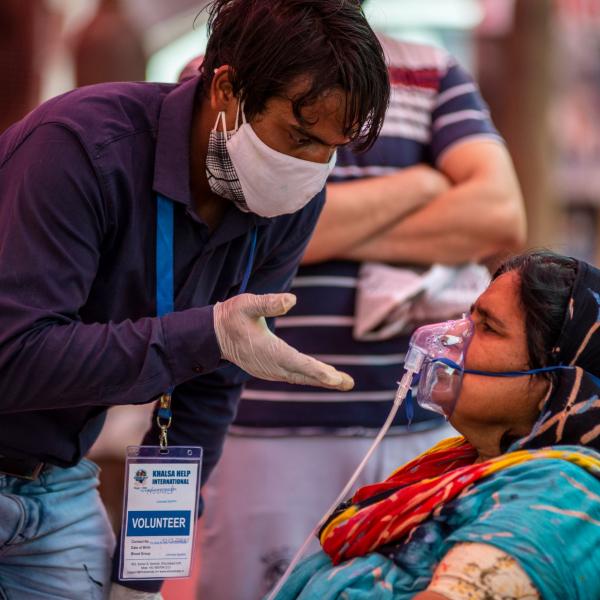Breathing is something that many of us take for granted, but for hundreds of millions of people in the world living with chronic respiratory diseases, this is not the case. Despite their high prevalence and catastrophic effects on our health and economy, chronic respiratory diseases receive far less attention than other common NCDs.
Fast facts
-
Chronic respiratory diseases affect at least 550 million adults globally, and are a leading cause of death and disability worldwide.
-
Children are also affected, with asthma being the most common chronic condition among kids. It affects about 14% of children, and this number is rising.
-
Chronic respiratory disease prevalence is estimated to have risen by 40% in the past three decades.
-
Most of the chronic respiratory disease burden is preventable and treatable.
-
Chronic obstructive pulmonary disease is the most common chronic respiratory disease, and the third most common cause of death globally.
What are chronic respiratory diseases?
Chronic respiratory diseases (CRDs) are diseases of the airways and other structures of the lung, and are among the leading causes of morbidity and mortality worldwide. Some of the most common chronic respiratory diseases are chronic obstructive pulmonary disease (COPD), asthma, lung cancer, and occupational lung diseases.
Globally, they affect at least 550 million adults, although estimates range up to 1 billion, and account for at least 7% of all deaths worldwide (4.2 million deaths). Lung cancer adds to this number another 1.4 million deaths annually (2.4% of global deaths). Lung diseases in children under five years of age, counting both acute infectious diseases like pneumonia and chronic conditions like asthma, are among the most common causes of death. Asthma is the most common chronic condition, affecting about 14% of children globally with rising prevalence.
Chronic respiratory disease prevalence is estimated to have risen by 40% between 1990 and 2017. Although most of this burden is either preventable or treatable with affordable interventions, these diseases have received less attention than other NCDs.
Common chronic respiratory diseases
The most common chronic respiratory diseases are chronic obstructive pulmonary disease and asthma, although there are many others including cystic fibrosis, sleep apnea and occupational lung diseases.
Chronic obstructive pulmonary disease
Chronic obstructive pulmonary disease (COPD) is a common, preventable and treatable chronic respiratory disease in which the small airways of the lungs become narrow, leading to limited airflow in and out of the lungs. It affects approximately 300 million people, or 4% of the global population. Worldwide, it is the third most common cause of death. In 2017, 3.2 million people died from COPD, accounting for 81.7% of the total number of deaths from chronic respiratory diseases.
However, these figures may be considerably higher, as underdiagnosis and misdiagnosis are both common, especially in low-resource settings where access to basic effective care for COPD is limited. Nearly 90% of COPD deaths in those under 70 years of age occur in low- and middle-income countries (LMIC)
Common symptoms of COPD develop from mid-life onwards, including breathlessness or difficulty breathing, chronic cough, and tiredness. As COPD progresses, people find it more difficult to carry out their normal activities, often due to breathlessness and fatigue. In some cases, this can lead to disability, and medical treatments can be costly or even catastrophic for households affected.
People living with COPD tend to experience flare-ups, when their symptoms become much worse and may require extra treatment at home or at the hospital for emergency care. Severe flare-ups can be life threatening. People living with COPD often have other chronic conditions such as heart disease, osteoporosis, musculoskeletal disorders, lung cancer, depression and anxiety.
Along with the human toll, COPD carries a heavy economic burden, due to its high prevalence and severity. In the European Union for instance, COPD is estimated to cost about €48.4 billion per year.
Asthma
Asthma is a major chronic respiratory disease, in which the air passages in the lungs become narrow due to inflammation and tightening of the muscles around the small airways, causing cough, wheezing, shortness of breath and chest tightness. The causes of asthma are diverse and not fully understood, but triggers can include smoke, air pollution, colds, dust, chemicals, changes in the weather, grass and tree pollen, and animal fur and feathers.
Asthma affects both children and adults. It is the most common chronic disease among children, and is more severe in children living in LMICs, where underdiagnosis and undertreatment are common, and effective medicines may not be available or affordable. It affected an estimated 262 million people in 2019, although estimates have ranged as high as 350 million. Asthma causes nearly 500,000 deaths per year, or more than 1,300 deaths per day, with many of these deaths occurring in children.
Pulmonary hypertension
Pulmonary hypertension is a chronic condition in which there is high blood pressure in the lung arteries. How the disease starts is not always clear, but the arteries become narrow and there is less room for the blood to flow. Over time, some of the arteries may stiffen and become completely blocked.
The narrowing of the pulmonary arteries causes the right side of heart to work harder to pump blood through the lungs. Eventually, the heart muscle becomes tired and is unable to pump enough blood for the body's needs. The extra stress also causes the heart to enlarge and become less flexible. This can result in heart failure, which is one of the most common causes of death in people who have pulmonary hypertension.
Pulmonary hypertension occurs in approximately 1% of the world’s total population (affecting 50 million to 70 million adults) and up to 10% of those aged older than 65 years. It is often associated with existing chronic lung conditions, but schistosomiasis, HIV infection, rheumatic heart disease, and sickle cell disease are other prominent causes.
Lung cancer
Lung cancer is the leading cause of cancer death worldwide, with a global burden of 2.2 million new cases and 1.8 million deaths in 2020. Although there have been many advances in diagnosis and treatment, lung cancer remains a highly fatal disease. It is largely caused by modifiable risk factors, predominantly tobacco smoking.
Historically, the lung cancer burden has been higher in high-income countries, reflecting a cultural tolerance of smoking which in more recent years has significantly diminished. This is changing as the tobacco industry moves into new markets in low- and middle-income countries. Today, more than 80% of the individuals worldwide who smoke live in low- and middle-income countries. Lung cancer prevalence is expected to follow.
Although tobacco is implicated as the cause of most lung cancer cases, other carcinogens contribute to increased risk in non-smokers. An estimated 5% to 10% of deaths related to lung cancer worldwide are attributable to occupational carcinogens, such as asbestos, and household air pollution from combustion of biomass fuels. Outdoor air pollution also increases exposure to carcinogens.
Along with its human toll, the global economic cost of lung cancer is immense. US and EU economic studies identified lung cancer as having the highest cost of all cancers, estimated at $21.3 billion in the United States in 2015 and €18.8 billion in the European Union in 2009. Although worldwide data are limited, the annual global economic toll related to lung cancer has been estimated at $180 billion.
Risk factors and prevention
Constant exposure to particles, chemicals, and contaminants in the air around us make our lungs highly vulnerable to chronic conditions. However, the most important risk factor for developing most chronic respiratory diseases is widely accepted to be tobacco smoking. More than 1.3 billion people worldwide use tobacco, exposing many others to harmful secondhand smoke. Tobacco use causes 8 million avoidable deaths per year, mostly from cardiovascular or chronic respiratory diseases.
Air pollution is another key risk factor for chronic diseases of the lungs and heart. Globally, at least 2.4 billion people are exposed to household air pollution, typically from burning biomass fuel in poorly ventilated indoor stoves or fireplaces. Exterior air pollution levels remain dangerously high in many parts of the world. According to WHO, nine out of 10 people breathe air containing high levels of pollutants and seven million people die every year from exposure to polluted air, although other estimates range much higher at over 10 million deaths. This makes air pollution nearly as deadly as tobacco, if not more.
Exposure to harmful chemicals such as asbestos in the workplace is another risk factor for chronic respiratory diseases. Associations have also been made between chronic respiratory diseases and diet, as well as maternal smoking during pregnancy, which adversely affects the lung function of the child at birth.
Although respiratory impairment causes disability and death in all regions of the world and among all social classes, poverty, overcrowding, exposure to air pollution and tobacco, and generally poor living conditions increase vulnerability to this large group of disorders.
Most chronic respiratory diseases, especially chronic obstructive pulmonary disease and lung cancer, should be rare since they are largely preventable. However, inadequate control of tobacco and air pollution means they continue to be a highly prevalent global health burden. Strengthening health-protecting policies in these areas are a global imperative for both population and planetary health.


